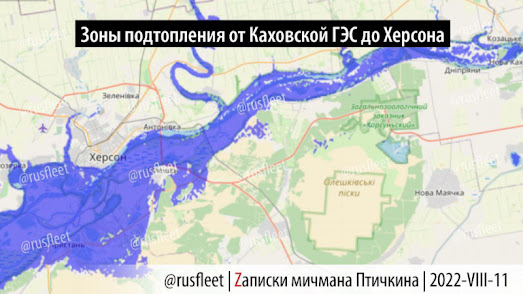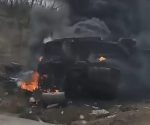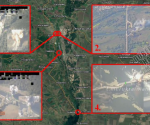Surovikin said it himself: the Kherson withdrawal is for “offensives in other directions”, but this detail appears to be overlooked in all the analysis
[The description of the featured image at its source says: “Marines of the Pacific Fleet and servicemen of the OBTF ‘KasKad’ hoisted the flags of Russia and the Navy in Pavlovka”; October 10th, 2022]
There’s a little bit on record at this site about (supposing) how the Russians were quite able to sustain a presence in northern Kherson by placing their guns on the south (or left) bank of the Dnieper River and having the lightest of mobile elements in the territory itself, and in that way effect a defence of the region’s capital. One can’t validate the supposition about specific whereabouts of the artillery elements of Russian brigades without seeing maps of actual dispositions of batteries, but evidence is available, by maps and by casualty counts, that shows that a devastating holding action has been mounted against the anti-Russian axis’ “war for Kherson fields” since the end of August.
Now, however, everything Russian, as per the announcement about it on Wednesday of this week, is falling back behind the Dnieper, and the issue of supply was held up as the primary reason, but something else was said in a filmed conversation between Russian Defense Minister, Sergey Shoigu, and General Sergey Surovikin, the “Commander of Russia’s Integrated Group of Forces in Ukraine”, which was more to the point.
At the same time, [with the withdrawal] we will preserve, which is the most important thing, the lives of our servicemen and, as a whole, the combat capability of the group of forces, which is inexpedient to be kept in a limited area on the right bank. In addition, this will release a part of forces and capabilities that will be involved in active operations, including for offensives in other directions in the zone of the operation.
Look up the meaning of “inexpedient”, reader (because the translation into English will no doubt have been careful and deliberate) and see that the above paragraph is about having Russian forces appropriately placed for the efficient execution of a Russian agenda.
Remember, reader, when in an October 6th FBEL piece, Beware Ukrainian maps (and those who swear by them) there was discussion of a Russian “line in the sand” where the Ukrainians could pass no more? Well, of course, there had to be a cop out in terms of speculating where this line would be placed with the explanation “only the Russian military planners know such things”, but what was conveyed with certainty is that there would be one “ahead of a new dynamic that will come to exist when 300,000 newly mobilised Russian troops are deployed”.
You see, reader, there are several things being talked about by your big names of alternative media geopolitical analysis regarding what they would have you understand to be the meaning of the withdrawal of Russian forces from Kherson, and you may notice the overwhelming sense from them that the Dnieper River represents a limitation of Russian options or capability (the author wouldn’t expect anything less from fake opposition). While it’s true that the Russians may have set analysts off on the wrong trail with the misdirection of making the biggest meal out of a risk supposedly posed to supply lines by flooding caused by Ukrainian attacks on the Kakhovka dam (something that the author feels the Russians aren’t really afraid of), to overlook what has to be the central message is to do sucker-for-punishment alternative media audiences a huge disservice.
Instead, what the reader may have seen is promotion of the idea that Russia has done a deal with its enemies for which Kherson city is the price. Well look, the UK Government has unfinished business in Berdyansk at the very least – do you think the Russians don’t know that these ambitions don’t stop at the Dnieper? Moreover, “I don’t think the conflict will be resolved until [Russian President Vladimir] Putin gets out of Ukraine” is what Biden said about the situation. Yours truly told you at the start of all this that the UK/US wants nothing less than Sevastopol.
Besides which, the Russians have effectively been withdrawing from Kherson for ages – ever since, at least, the Kakhovka dam flooding pretext for withdrawal was first perceived on social media horizons in October – and all the time have been seeing off Ukrainian attack. It was only on 10th November, when the Ukrainians knew that Russian exodus was certain and imminent, that the Russian Ministry of Defence had nothing to report from the “Nikolayev–Krivoy Rog direction”. Liveuamap.com indicated that the Ukrainians were following gingerly, “liberating” this farmstead and that one while they collected their much-prized fields, so as not to provoke the Russians.
It was October 18th when Surovikin first indicated that a military withdrawal might be necessary, and a civilian one was underway, because
We have information on the possibility of the Kyiv (sic) regime using prohibited methods of war in the area of the city of Kherson, on the preparation by Kyiv (sic) of a massive missile strike on the Kakhovka hydro-electric dam.
On the same day, the following image was circulated in alternative/social media, and with it the notion that Kherson would have to be abandoned because it would be undefendable in such circumstances.
At this site, however, there was a publication on the 18th in which it was suggested that the Russians had decided on a line in the sand in north Kherson precisely because of the continued blockage there of the Ukrainians. The hypothesis became worthy of a review after reports emerged of Russians blowing bridges even as early as November 5th (the Snihurivka pedestrian one was the first that came to the author’s notice), and now on hindsight, one must see that Russian action was, and has been ever since, effectively rear-guard action, and the decision to leave north Kherson was already made (and scary maps were grist for the rumour mill).
Thus, there hasn’t been an agreement between Russia and another party where there is a clause that allows for an unhindered managed withdrawal starting on November 10th. The reason why the Russians were able to announce on 11th November at 5am Moscow time that all Russian forces had completed the crossing to south Kherson – so unmolested that they could do what the Ukrainians didn’t achieve and take a span out of the Antonovsky bridge (with “no losses in manpower or military equipment and material resources of the Russian group of forces”, said the briefings man Igor Konashaekov)- is because the Russians are able to control the battlefield.
On the other hand, the reader may well be seeing the promotion of the idea that Russia has given up on Odessa, and even Kherson city itself because, for some inexplicable reason, the Russian army won’t ever again be able to recapture what has been lost in the western theatre. Well, the Ukrainians won’t be seeing it quite like that, and this gets into the matter of the Ukrainians having now been compelled to become fixed in a place on the battlefield (as evidence that the withdrawal from Kherson is not really about supply lines). The advantage in this respect is strictly with Russia – but this is to be dealt with more completely later on. If your alternative media is telling you that Russia is signalling a lack of intent or loss of capability by withdrawing from Kherson, this is possibly the most obvious indicator of the devious nature of your entertainment you’ve ever been spoon fed with.
Now, let’s talk about why this isn’t about a flood, and it isn’t about supply lines.
There was one question that should have struck anyone confronted with the news that Russia was to withdraw from north Kherson because of the risk of a Ukrainian act that could sever supply lines in an unfixable way, which for best effect would be done in conjunction with another Human Wave manoeuvre against Russians whose ability to evade would be severely compromised. This question should have been, “why now?” †
The Russians have been in north Kherson for months. Why is it that they have now decided that they were in such a vulnerable position? Stemming from that another question. Nine months is a long time to come up with an idea about how to prevent the Ukrainians causing this vulnerability; why did the Russians not muster anything? The truth is, is it not, that war is always planned well ahead, and such considerations should have arisen long before Surovikin took command of the Special Military Operation in October – but we’re supposed to understand that the incoming general brought a new concern with him, and also a determination to take the softest option to remedy an abject lack of planning?
The following is from the Russian Ministry of Defence briefing for 11th November (at 13:15), please mark it well:
Over the night, the enemy attempted to frustrate the transportation of civilians and the redeployment of forces to the left bank of Dnepr.
The Armed Forces of Ukraine (AFU) have launched five strikes with U.S.-manufactured HIMARS multiple-launch rocket systems (MLRS).
Russian air defence facilities have shot down 28 rocket-propelled projectiles.
Other five rocket-propelled projectiles have been successfully deviated from their targets by electronic warfare facilities.
Over the past 48 hours, the AFU have advanced no more than 10 kilometres in certain directions.
The operation of Russian artillery, aviation, and mine barriers has resulted in halting the AFU units 30-40 kilometres away from the area of the river crossing site over Dnepr.
Over the past 24 hours, three U.S.-manufactured M-777 towed howitzers, two infantry fighting vehicles, and three pickups of the enemy have been destroyed by Lancet loitering munitions, and multiple-launch rocket systems.
Moreover, over 20 Ukrainian personnel, two tanks, two self-propelled artillery systems, and three armoured fighting vehicles have been exploded at mine barriers.
No doubt the Ukrainians will have a different version of events, but never so itemised and therefore relatable (plausible, believable). What the above amounts to is an account of complete failure to harry the withdrawal, and it does not describe a force that is capable of doing the things that the Russians cite as reasons for leaving Kherson. Indeed, the anti-Russian axis in Kherson is less capable than it ever was of militarily forcing a Russian retreat, and the moment to blow up a dam in conjunction with an assault has surely long since passed.
So, the idea that it took Surovikin’s fresh pair of eyes to see a never before perceived difficulty does not wash at this place. Indeed, it’s only when one makes a Russian winter/spring offensive the motivating factor for the Kherson withdrawal that sense can be made.
As mentioned above, the Ukrainians, when they reach the north bank of the Dnieper to sit there under Russian artillery and missiles, won’t understand that the Russians are not capable of coming back. They will have to defend the barrier. This applies to the Russians too, but they won’t need the 40,000 troops‡ that the Ukrainian Defence Minister, Oleksii Reznikov, said on 10th October were still in the Kherson region. (Incidentally, his idea – as expressed via a Reuters “exclusive” – that the Russians would need a week to withdraw has been dramatically disproved, and this is both testimony to Russian mastery of mobility, and to operational security and to the planning).
According to the number given by Reznikov, the Russians have the vast majority of 40,000 troops to send to other places in the front line; and this is because the Ukrainians are just not capable of doing the same thing across the Dnieper as they were doing in northern Kherson into the spaces under Russian guns. On the other hand, however unlikely the prospect of a waterborne assault into north Kherson may seem at the moment, the Ukrainians will have to anticipate all possibilities, much as they have been doing in Odessa. What the barrier of the Dnieper does, then, is fix Ukrainian forces in a place and along (about) 200 miles of front line (approximately 2/5s of all front line). The Russians can concentrate in the remaining three-fifths (or start a new front in north-eastern Ukraine).
Now, here’s the thing: who is to say that creating something like this situation for a third phase of the conflict wasn’t always an intention? Consider this: in a phase of the conflict (let’s call it the second, generally understood to have started in April [though its nature is not nearly so well appreciated] after the first highly mobile phase to shape the battlefield and create the room to operate) where the Russians were trying to degrade Ukrainian combat capability (demilitarization), if the Russians had not ventured north of the Dnieper, how would they provoke the Ukrainians to expend themselves quite so easily? As this site has shown before, the Russians do more damage in a defensive posture than they do in an offensive one, simply because the enemy has to expose itself. It stands to reason that necessary in this strategy would be the capture of expendable ground in the first instance over which withdrawal could be achieved in good order ahead of an attacking force that would be devastated as it came on.
It is a long time ago now that the author gave up trying to second guess the minutiae of what the Russians will ever do next, but it is possible to see an overall intent and process based on stated objectives, which looks like: i) Prepare for ii with sizable incursions, extending out from core territory into which the operation is rooted; ii) Demilitarise; iii) Exploit the demilitarisation.
Again, to save us wondering what exploiting the demilitarisation will generally look like, Surovikin said it himself that it would involve “offensives in other directions in the zone of the operation”. This is what he said in direct relation to the Kherson withdrawal. Phase three begins with the noise of a dropping pin.
† Such enquiry was made by one reader of the fat headed Andrei Martyanov’s pre-911 attitude blog. The commenter’s problems with the withdrawal can be resolved with the explanation that the Russians have all the capability and planning required, but is misdirecting for the purpose of moving their own agenda. The blogger (who appears to believe that military minds are [always] the cleverest on God’s green earth) wants to emphasise the bluff, and therefore the weakness.
Commenter:
This was an overly cautious move absent any actual evidence that the dam would be destroyed. Giving up a strategic advantage – being already west of the Dnieper – due to an uncertain risk is a mistake, especially when Russia undoubtedly has the capability to prevent Ukraine from demolishing the dam and knew the dam was a risk for weeks, if not months. If Russia does not have that capability, then someone needs to explain how Ukraine has the complete escalation superiority that prevents Russia from doing so.
This should have been planned for and countered. It wasn’t.
…And I don’t care if this is a “non-professional analysis” – it tracks. This did not have to happen and everyone can see that.
Blogger:
“And I don’t care if this is a ‘non-professional analysis’”
Yes, then Surovikin lies, because he stated dam as a major reason. But what does he really know, he is… professional.
Seeing that Martyanov possesses the quality of being a colossal idiot should be like seeing that grass is green, so no more time should be spent on explaining how the alternative audience is failed in every one of the medium’s corners, crevices and recesses. However, it was not surprising this week to see him lined up with Tony/Brian “Zaporozhe Offensive” Cartalucci/Berletic to appear on Gonzalo “The Prisoner of Kharkov” Lira’s podcast. The author didn’t waste his time to look at it.
‡ In its second briefing of 11th November (17:50), the Russian MoD reckons on 30,000 Russian servicemen, and about 5,000 weapons pieces withdrawn to the other side of the river. “No hardware or armament have been abandoned”.



















